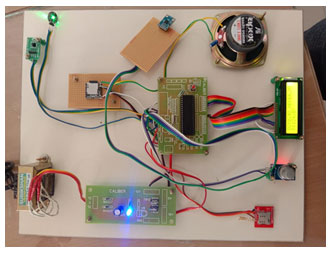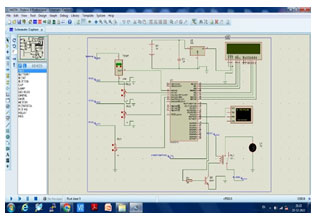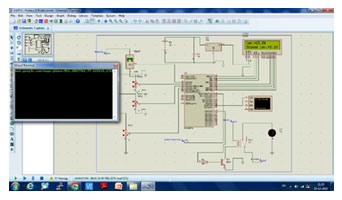Department of Electronic’s and Communication Engineering, Nandha
Engineering College , Erode, Tamil Nadu, India.
Corresponding author email: brindha.bliss@gmail.com
Article Publishing History
Received: 25/12/2022
Accepted After Revision: 14/02/2023
Paraplegia is a paralysis that affects the legs and often seriously affects the lower half of a human body. Paraplegia happens whilst there may be damage underneath the neck. The maximum common motive is trauma, such as sports injury or vehicle accident. other causes are stroke, spine tumors, together with cancers. This paper provides a novel design to enhance the conversation of paralysis sufferers. The device is a clever glove that is used to seize hand gestures and convert them into verbal commands. The glove is geared up with sensors and processors that discover the hand gestures and convert them into indicators. The tool is designed to be simple and user-friendly, allowing patients to quickly adapt to its use. The tool is likewise designed to be low-cost and handy, permitting more paralysis patients to use it.
The device is tested and evaluated for its performance, and the outcomes display that it may accurately capture and interpret the hand gestures of the sufferers. In most cases paralyzed affected person (like Monoplegia, Hemiplegia, Paraplegia) aren’t capable of interact or communicate with others or their caretaker. This net of factors primarily based clever glove facilitates the affected person to convey their needs to the caretakers. It measures pulse, temperature, blood pressure and gyro. In gyroscope sensor there is a message, based at the route or motion in which it can be conveyed thru show and audio. it is able to screen thru internet and smart telephones. but it can not be used for tetraplegia patient. It is concluded that in quadriplegia as patients can not move their body, if in future we can able to read the neuron signals of the patients through sensor or any device and then we can able to understand what they need or what they want. Consequently the system can be able to display or hear through audio which can be used according to the need, updating into neuro reading sensors which are economically viable.
Smart Glove, Heart Rate Sensing, Gesture, Temperature, GSM, Speaker, Display
Brindha. S, Deepak. S, Deepak. M, Richarson. P. I, Hariharan. R. IOT Based Paraplegia Patient Communication Device Using Smart Glove. Biosc.Biotech.Res.Comm. 2023;16(1).
Brindha. S, Deepak. S, Deepak. M, Richarson. P. I, Hariharan. R. IOT Based Paraplegia Patient Communication Device Using Smart Glove. Biosc.Biotech.Res.Comm. 2023;16(1). Available from: <a href=”https://bit.ly/3lllL18“>https://bit.ly/3lllL18</a>
INTRODUCTION
According to a survey conducted by WHO in Every year, around the world, between 250 000 and 500 000 people suffer a spinal cord injury (SCI). The majority of spinal cord injuries are due to preventable causes such as road traffic crashes, falls or violence. Males are most at risk in young adulthood (20-29 years) and older age (70+). Females are most at risk in adolescence (15-19) and older age (60+). Studies report male-to-female ratios of at least 2:1 among adults, sometimes much higher. This type of patient is can’t able communicate with others like normal people like drinking, switching on fan. After analysing this problem, we propose a machine known as smart glove with a view to combine a function to serve the disabled individuals and assist them to speak freely with the open world. They can send a message to their caretaker; they can call to their doctor for any assistant. Consequently, at the same time as these controls are beneficial for a generally abled character, they may be not very beneficial for the bodily handicapped or especially, the aged people, who do now not have the capability to use sufficient strain to move their hand.
Workers have proposed a first-generation prototype glove, where the glove converts gesture to text, just by moving the fingers. The blind person cannot walk casually in busy roads, the glove has an in-built obstacle sensor. The buzzer will ring when an object comes in front of the person (Nair, 2020, Kumar 2021). This is a unique device which incorporates multiple sensors, making it capable to do multiple tasks. Proposed a majorly useful for deaf and dumb, paralyzed patient to monitor their mental health by displaying the output commands in android application with vocal output in speaker. In case of emergency, GSM will send alert message to the respective person (Nair, 2020, Kumar 2021).
Proposed devices are mostly used in ICU to monitor the patient health in real-time, where the data is uploaded to the webserver and to the mobile application in which the output can be taken by doctor using the application (Babar & Rahman 2021). The doctor can categorize the patients by their status using an “IoT Based Patient Checking systems like framework utilizing TCP/IP convention, where the patient wellbeing is constantly followed even from the remote end. Also, with the assistance of set off notice SMS and call we can help the patient by taking vital choices right away as suggested by Sujin et al., (2021).
Furthermore, empowering the specialist to give medical aid remotely my observing the patient medical issue remotely which is made accessible internationally proposed a real time ECG signal was displayed on the web and storing it in the cloud server. In this they use a high-speed network so, there are no packages loss and package error during transmission. The doctor or nurse can observe the ECG signal of any patient at any place through the computer or smartphone without going to wards. This reduces the patient travelling time from rural or suburban areas. It also indicates the abnormal reading from the ECG signal (Yew et al., 2020, Fraiwan et al., 2018).
MATERIAL AND METHODS
Figure1: Block diagram

ADXL is an acceleration detection sensor. It works under the principle of capacitive. It works when the acceleration is applied to the sensor, the capacitive inside the sensor changes. This change in capacitance is then used to measure the acceleration of the object. PIC is a family of microcontrollers. It is manufacture by microchip technologies. It comes under PIC1650(8-bit microcontroller).PIC refers to Peripheral interface controller. PIC is a one chip microcontroller (it is used to solve small task in a simple and cheap way). It has 40 pins. It has 33 I/O pins. Liquid crystal display (LCD) is a flat display technology. It is used to display the information. GSM (Worldwide Framework for Portable correspondence) is a computerized versatile organization that is broadly involved by cell phone clients in Europe and different regions of the planet. GSM utilizes a variety of time division various access (TDMA) and is the most broadly utilized of the three computerized remote communication innovations: TDMA, GSM and code-division different access (CDMA) (Athota 2020, Chouhan 2014, Rao 2013).
GSM digitizes and packs information, then sends it down a channel with two different floods of client information, each time permitting space. It works at either the 900 megahertz (MHz) or 1,800 MHz recurrence band. Mp3 a packed computerized sound record (Athota 2020, Chouhan 2014, Rao 2013). A player stores these records on a memory chip with the goal that you can play it back at your relaxation. Contains a little hard plate drive, which can store enormous amounts of information. MP3s normally contain music, however the configuration is additionally utilized for general sound documents, for example, book recordings and webcasts. Audio system work through changing electricity into mechanical energy (motion). The mechanical energy compresses air and converts the motion into sound power or sound pressure stage. while an electric current is sent via a coil of cord, it induces a magnetic field (Ganeson 2016, Tmaura 2013).
- Create a design plan: The first step in creating a paralysis patient communicating device using a smart glove is to come up with a design plan. The plan should include the type of components to be used, such as the accelerometer (ADXL), PIC controller, GSM, LCD, MP3 and speaker, as well as the overall design of the device.
- Implement the design: Once the design plan is complete, the next step is to implement the design. This involves connecting the components to each other and programming the device with the necessary software. Considerations should be made for the patient’s comfort, as well as the device’s ability to withstand being handled by the patient.
- Test the device: After the device is assembled, it should be tested to make sure that it is working as expected. This includes testing its ability to detect the patient’s movements, as well as its ability to communicate with the GSM and MP3.
- Evaluate the device: Once the device is tested, it should be evaluated to ensure that it is working properly and providing the intended results. This includes testing the device for accuracy and reliability.
- Make necessary modifications: If necessary, modifications should be made to the device to improve its performance. This could include adding additional sensors or programming more complex algorithms.
- Deploy the device: After all of the necessary tests and modifications are complete, the device should be deployed to the patient. This involves setting up the device and training the patient on how to use it.
- Monitor the device: Once the device is deployed, it should be monitored to make sure that it is working properly and providing the desired results. This could include collecting data on the patient’s movements and responses to the device.
RESULTS AND DISCUSSION
Figure 2: Hardware Kit

Figure 3: Basic Connection

Figure 4: Command 1 (up)

Figure 5: Command 2 (down)

Figure 6: Pressure Sensor Output

Figure 7: Heart Beat Rate

Figure 8: GSM

The Paralysis Patient Communicating Device using Smart Glove is a revolutionary device that can help people with paralysis to communicate with others. It is equipped with ADXL, PIC Controller, GSM, LCD, MP3 and Speaker which are used to detect user’s hand gestures and convert them into commands. This device can help the user to type messages, play music, and even make calls. The device can be used as a communication tool to bridge the gap between the user and the other person. This device can be a great help to those who are suffering from paralysis and cannot communicate verbally.
CONCLUSION
It is concluded that in quadriplegia as patients can not move their body, if in future we can able to read the neuron signals of the patients through sensor or any device and then we can able to understand what they need or what they want. Consequently the system can be able to display or hear through audio which can be used according to the need, updating into neuro reading sensors which are economically viable.
REFERENCES
Akshay D. R and Rao K. U (2013). Low-cost smart glove for remote control by the physically challenged,” 2013 IEEE Global Humanitarian Technology Conference: South Asia Satellite (GHTC-SAS), Trivandrum, India pp. 36-39.doi: 10.1109/GHTC-SAS.2013.6629884
Akshay D. R. and Rao K. U (2013). Low-cost smart glove for remote control by the physically challenged IEEE Global Humanitarian Technology Conference: South Asia Satellite (GHTC-SAS), Trivandrum, India pp. 36-39.doi: 10.1109/GHTC-SAS.2013.6629884
Athota L, Shukla V. K, Pandey N and Rana A (2020). Chatbot for Healthcare System Using Artificial Intelligence, 8th International Conference on Reliability, Infocom Technologies and Optimization (Trends and Future Directions) (ICRITO), Noida, India, pp.619622. doi:10.1109/ICRITO48877.2020.9197833
Babar E. T. R. and Rahman M. U(2021). A Smart, Low Cost, Wearable Technology for Remote Patient Monitoring,” in IEEE Sensors Journal, vol. 21, no. 19, pp. 21947-21955, doi: 10.1109/JSEN.2021.3101146.
Bernieri G, Faramondi L. and Pascucci F (2015). A low-cost smart glove for visually impaired people mobility, Mediterranean Conference on Control and Automation (MED), Torremolinos, Spain, pp. 130-135.doi: 10.1109/MED.2015.7158740
Chouhan T, Panse A, Voona A. K and Sameer S. M (2014). Smart glove with gesture recognition ability for the hearing and speech impaired, IEEE Global Humanitarian Technology Conference – South Asia Satellite (GHTC-SAS), Trivandrum, India, 2014, pp. 105-110. doi: 10.1109/GHTC-SAS.2014.6967567
Chouhan T, Panse A, Voona A. K and Sameer S. M (2014). Smart glove with gesture recognition ability for the hearing and speech impaired IEEE Global Humanitarian Technology Conference – South Asia Satellite (GHTC-SAS), Trivandrum, India pp. 105-110.doi: 10.1109/GHTC-SAS.2014.6967567
Fraiwan L, Basmaji T and Hassanin O (2018). A Mobile Mental Health Monitoring System: A Smart Glove International Conference on Signal-Image Technology & Internet-Based Systems (SITIS), Las Palmas de Gran Canaria, Spain, pp. 235-240.doi: 10.1109/SITIS.2018.00043
Ganeson S, Ambar R and Jamil M. M. A(2016). Design of a low-cost instrumented glove for hand rehabilitation monitoring system 6th IEEE International Conference on Control System, Computing and Engineering (ICCSCE), Penang, Malaysia pp. 189-192.doi: 10.1109/ICCSCE.2016.7893569
Nair M. R. A. S, Shreya A, Tharun C and Neethu K. N (2020). Design and Implementation of Smart Gloves for The Specially Privileged, Third International Conference on Advances in Electronics, Computers and Communications (ICAECC), Bengaluru, India, pp.15.doi:10.1109/ICAECC50550.2020.9339475
Nair M. R. A. S, Shreya A, Tharun C and Neethu K. N (2020). Design and Implementation of Smart Gloves for The Specially Privileged Third International Conference on Advances in Electronics, Computers and Communications (ICAECC), Bengaluru, India pp. 1-5. doi: 10.1109/ICAECC50550.2020.9339475
Praveen N, Karanth N and Megha M. S(2014). Sign language interpreter using a smart glove International Conference on Advances in Electronics Computers and Communications, Bangalore, India, 2014, pp. 1-5.doi: 10.1109/ICAECC.2014.7002401
Saleh N, Farghaly M, Elshaaer E and Mousa A (2020). Smart glove-based gestures recognition system for Arabic sign language International Conference on Innovative Trends in Communication and Computer Engineering (ITCE), Aswan, Egypt. pp. 303307.doi:10.1109/ITCE48509.2020.9047820
Senthil Kumar R, Leninpugalhanthi P, Rathika S, Rithika G and Sandhya S (2021). Implementation of IoT Based Smart Assistance Gloves for Disabled People International Conference on Advanced Computing and Communication Systems (ICACCS) pp. 1160-1164, doi: 10.1109/ICACCS51430.2021.9441855.
Sujin J, Mukesh S, Praveen Raj M. J, Sashwanth M and Ramesh Kumar R (2021). IoT based Patient Monitoring System using TCP/IP Protocol. International Conference on Advanced Computing and Communication Systems (ICACCS), 2021, pp. 1076-1080, doi: 10.1109/ICACCS51430.2021.9441910.
Tmaura T, Zakaria N. A, Kuwae Y, Sekine M, Minato K and Yoshida M (2013). Quantitative analysis of the fall-risk assessment test with wearable inertia sensors,” 2013 35th Annual International Conference of the IEEE Engineering in Medicine and Biology Society (EMBC), Osaka, Japan, pp. 7217-7220.doi: 10.1109/EMBC.2013.6611223
Yew H. T, Ng M. F, Ping S. Z, Chung S. K, Chekima A and Dargham J. A (2020). IoT Based Real-Time Remote Patient Monitoring System IEEE International Colloquium on Signal Processing & Its Applications(CSPA) pp.176179,doi:10.1109/CSPA48992.2020.9068699.


